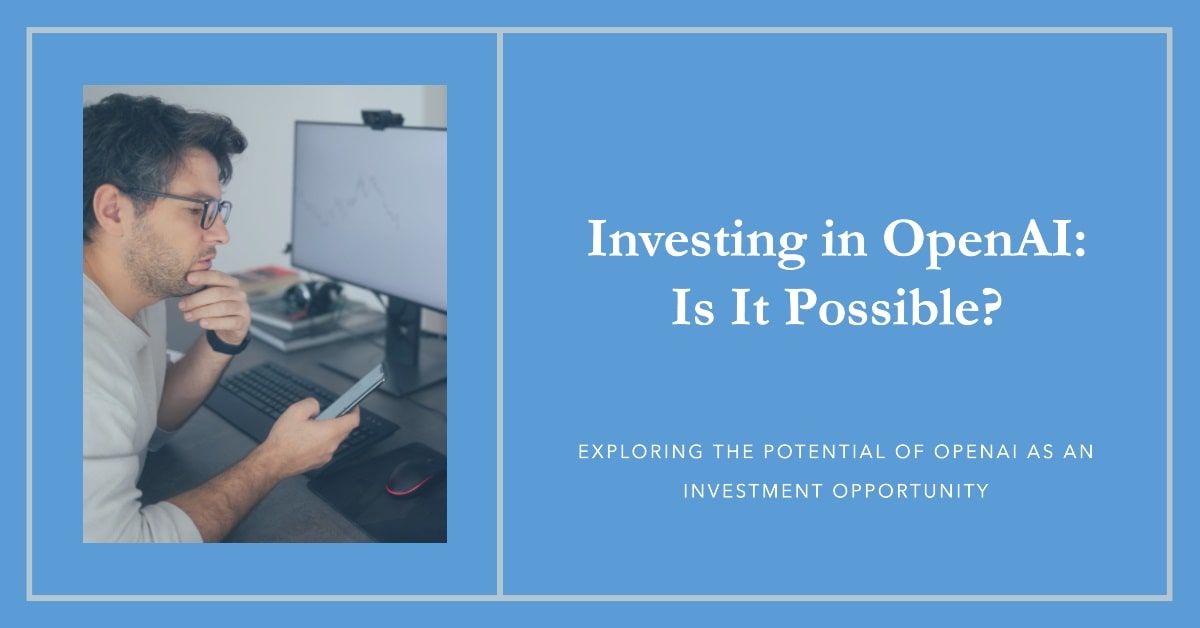Introduction
OpenAI, a leading name in the artificial intelligence industry, has been at the forefront of AI advancements. With innovations like the ChatGPT text generator and the Dall-E image generator, OpenAI has set new standards in the AI domain. Given its significant contributions and advancements, many investors and tech enthusiasts are curious about the possibility of investing in OpenAI. This article delves into the details of the company’s stock status, its ownership, and how one might get exposure to the company.
OpenAI’s Market Presence
OpenAI is recognized as one of the top three AI labs globally. It has not only developed AI software that can outperform humans in video games like Dota 2 but is also renowned for its AI text generator, ChatGPT. Before the rise of ChatGPT, OpenAI’s image generator, Dall-E, was a significant topic of discussion in the AI community. The capabilities of the company’s applications span from creating art to writing essays and even developing computer programs that surpass many human developers.
Stock Availability
A common question that arises is, “Can you buy OpenAI stock?” If you’ve tried searching for OpenAI on stock trading apps, you’d notice the absence of an the company’s stock symbol. The reason is simple: OpenAI is a private company, and its stock isn’t available for public purchase. Companies often opt to stay private either because they don’t need to raise capital through an IPO or to focus on business development without the pressures of Wall Street. However, just because OpenAI’s stock isn’t directly available doesn’t mean there aren’t ways to gain exposure to the company.
Who Owns OpenAI?
OpenAI was initially founded as a non-profit organization in 2015 by Elon Musk and several partners. By 2019, a for-profit entity, OpenAI LP (Limited Partnership), was established under the non-profit parent company, OpenAI Inc. In the same year, OpenAI LP secured a $1 billion investment from Microsoft, making it the most significant contribution to date. Furthermore, GPT-3 is exclusively licensed to Microsoft and its Azure cloud service. Other notable investors include Amazon Web Services and Infosys, though the exact investment amounts remain undisclosed.
Microsoft’s Stake in OpenAI
In January 2023, Microsoft declared a substantial multi-year investment in OpenAI. While the exact amount remains undisclosed, rumors suggest it could be as high as $10 billion. This collaboration marks the third phase of the partnership, following previous investments in 2019 and 2021. Given Microsoft’s significant stake and collaboration with the company, investing in Microsoft (NASDAQ: MSFT) might be a viable way to indirectly gain exposure to OpenAI’s success.
Alternative Investment Avenues
Apart from Microsoft, other companies have collaborated or partnered with OpenAI. For instance, all GPT-3 models have been trained using Nvidia’s GPUs. Nvidia (NASDAQ: NVDA), with its advanced AI hardware and software infrastructure, is another potential investment avenue. Alternatively, investing in AI competitors like Google’s DeepMind might also be an option. DeepMind has models that rival GPT-3, making Alphabet stock (NASDAQ: GOOGL) a potential choice for those looking to invest in the AI industry.
OpenAI’s User Base
ChatGPT has witnessed a meteoric rise in its user base since its inception. Here’s a detailed look into the user statistics of ChatGPT:
Rapid Growth
ChatGPT’s growth has been nothing short of phenomenal. Within just five days of its launch in November 2022, ChatGPT acquired a staggering 1 million users. To put this in perspective, Instagram took approximately 2.5 months to reach the same milestone, while Netflix took around 3.5 years. By January 2023, ChatGPT had already amassed 100 million monthly active users, making it one of the fastest-growing applications in history.
Current User Statistics
As of June 2023, ChatGPT boasts over 100 million users. The platform witnessed a record-breaking growth in traffic from April to June 2023, with the website generating 1.6 billion visits in June alone. This rapid user and traffic growth underscores the platform’s popularity and the increasing reliance on AI-driven chatbots.
User Engagement
ChatGPT’s engagement metrics are equally impressive. On average, a ChatGPT visitor views about 4.26 pages per visit and spends approximately 7 minutes and 27 seconds on the website. The bounce rate stands at 38.67%, indicating a high level of user engagement and satisfaction.
Regional Distribution
The United States leads the pack with 12.12% of ChatGPT users, followed by India at 7.61%. Japan, Brazil, and Colombia also feature in the top five countries by user base. Collectively, these five countries account for almost one-third of all ChatGPT users.
Age Demographics
Diving into the age demographics, 17% of users aged between 30 to 44 have used ChatGPT since January 2023. The 18 to 29 age bracket isn’t far behind, with 15% having used ChatGPT to generate text. Older age groups also show a notable presence, with 9% of 45 to 64-year-olds and 5% of those aged 65 and above using ChatGPT.
The Future: OpenAI IPO
The company’s rapid growth and influence in the AI industry have naturally led to speculations about its potential Initial Public Offering (IPO). Here’s a deeper dive into the current status and future prospects of an OpenAI IPO:
Current Stance on IPO
As of June 2023, OpenAI’s CEO and co-founder, Sam Altman, stated that the company has no immediate plans to go public. There are two primary reasons behind this decision:
- Capital Requirements: OpenAI currently does not seem to be in urgent need of additional capital. This is evident from the significant investments it has received from tech giants like Microsoft.
- Developmental Freedom: OpenAI believes that going public might restrict its ability to fully develop AI. The company is deeply committed to developing artificial general intelligence (AGI) and AI superintelligence. These are technologies that are self-aware and possess intelligence surpassing even the most brilliant humans. Altman expressed concerns about potential investor reactions to some of the decisions they might make in the pursuit of superintelligence. He mentioned, “When we develop superintelligence, we are likely to make some decisions that most investors would look at very strangely.”
Financial Health
While OpenAI does not publicly release its financial statements, reports from May 2023 suggest that the company is not currently profitable. The company reportedly incurred losses close to $540 million in 2022, which was roughly double from the previous year. This rapid scaling and aggressive development have required substantial investments in cloud computing services, staffing, and the creation of AI supercomputers.
Future Possibilities
While the current stance is clear, the future is always uncertain. Many successful private companies eventually decide to conduct an IPO to raise additional capital and fuel their growth. If OpenAI’s capital requirements change or if there’s a strategic shift in its business model, the possibility of an IPO could be revisited.
Moreover, the company’s unique organizational structure, which it refers to as a “capped-profit” company, allows investors and employees to participate in profits up to a defined cap. This structure might make an IPO more appealing in the future, as it offers a balance between profit-making and mission-driven objectives.
Conclusion
OpenAI, with its groundbreaking advancements in the realm of artificial intelligence, has undeniably captured the attention of both the tech industry and potential investors. Its rapid ascent, marked by innovations like ChatGPT and Dall-E, has not only showcased the potential of AI but also set new benchmarks for what technology can achieve.
While direct investment opportunities in OpenAI remain elusive, the company’s trajectory offers several insights:
- The Power of AI: OpenAI’s success underscores the transformative potential of AI. From enhancing productivity to creating art, the applications are vast and continually expanding. This serves as a reminder that we are only scratching the surface of what AI can accomplish.
- Strategic Partnerships: OpenAI’s collaborations with tech giants like Microsoft highlight the importance of strategic partnerships in the tech world. Such alliances not only provide financial backing but also pave the way for integrated solutions that can redefine industries.
- Future of Investment: Even though OpenAI’s stock isn’t available for direct purchase, its journey offers a blueprint for potential investors. By observing the company’s growth and its impact on partners like Microsoft, investors can identify and capitalize on indirect investment avenues.
- Evolving Business Models: OpenAI’s “capped-profit” model is a testament to the evolving nature of business structures, where mission-driven objectives can coexist with profit-making goals. This could inspire other startups and established companies to explore hybrid models that balance societal impact with financial growth.
- Anticipation of the Future: While OpenAI’s current stance on IPO is clear, the dynamic nature of the tech industry means that nothing is set in stone. As the company continues to grow and the landscape of AI evolves, there might be shifts in strategy, offering new opportunities for investors.
In essence, OpenAI’s journey is not just about a company’s growth in the AI sector; it’s a reflection of the evolving tech landscape, the power of innovation, and the myriad possibilities that the future holds. For investors, tech enthusiasts, and even the average individual, keeping an eye on the company’s trajectory is akin to getting a glimpse into the future of technology and its profound impact on our world.
FinBrain Technologies
99 Wall St. #2023
New York, NY 10005


Leave a Reply